Performatik: the here and now of performance art
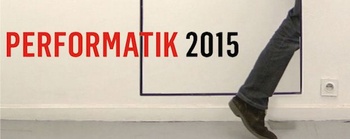
The fourth edition of Performatik turns the spotlight on artists who tinker with the codes of the theatre and/or of the visual arts. The event’s curator, Katleen Van Langendonck (of the Kaaitheater) stresses that the programme’s content and organisation are due to the contributions of no fewer than ten partners. She tips seven events at this Brussels biennale for performance art.
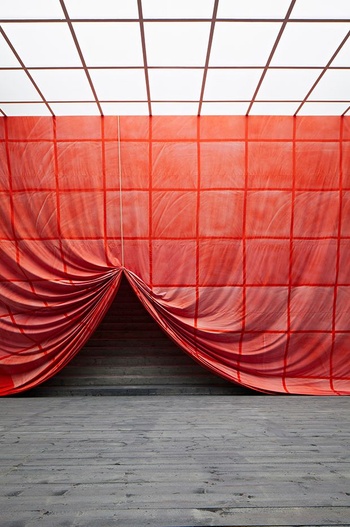
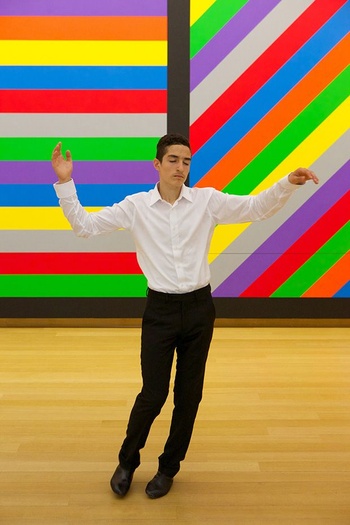
(Baisse-toi montagne, lève-toi vallon © Wolfgang Thaler - Courtesy The Artist & Art Concept Paris / A Possibility of an Abstraction © Ernst van Deursen)
SAINT-SIMONISME
“The French-German visual artist Ulla von Brandenburg gets things under way with her first major theatre performance, a new work for 25 choir members from the Brussels Brecht-Eislerkoor and five onstage actors. The show is based on the customs and rituals of Saint-Simonisme, a communist community in 19th-century Paris. Their basic aim was to abolish all privileges on the basis of birth and to operate on the basis of everyone’s possibilities. Sadly, that still remains a utopian idea today. Von Brandenburg wrote the libretto herself and paid particular attention to the sets and costumes, on which she worked with students from the London College of Fashion. After its Brussels premiere, the production moves to the Performa festival in New York. I’m really curious about it.”
Ulla von Brandenburg: Baisse-toi montagne, lève-toi vallon. 18 & 19/3, Kaaistudio’s
GRANDES DAMES
“Two Brussels grandes dames, Joëlle Tuerlinckx and Anne Teresa De Keersmaeker, switch from museum to theatre and vice versa. Tuerlinckx calls this ‘total spectacle’ une lecture d’un travail.
SAINT-SIMONISME
“The French-German visual artist Ulla von Brandenburg gets things under way with her first major theatre performance, a new work for 25 choir members from the Brussels Brecht-Eislerkoor and five onstage actors. The show is based on the customs and rituals of Saint-Simonisme, a communist community in 19th-century Paris. Their basic aim was to abolish all privileges on the basis of birth and to operate on the basis of everyone’s possibilities. Sadly, that still remains a utopian idea today. Von Brandenburg wrote the libretto herself and paid particular attention to the sets and costumes, on which she worked with students from the London College of Fashion. After its Brussels premiere, the production moves to the Performa festival in New York. I’m really curious about it.”
Ulla von Brandenburg: Baisse-toi montagne, lève-toi vallon. 18 & 19/3, Kaaistudio’s
GRANDES DAMES
“Two Brussels grandes dames, Joëlle Tuerlinckx and Anne Teresa De Keersmaeker, switch from museum to theatre and vice versa. Tuerlinckx calls this ‘total spectacle’ une lecture d’un travail.
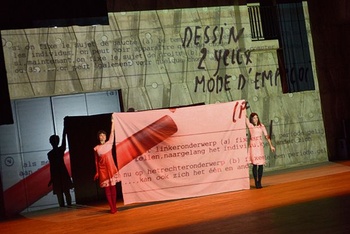
In what I would describe as a choreography of space, the artist transforms the basic elements of a theatre – light, sound, projection, curtains, orchestra pit, framing, and so on – into actors. Watching it, I personally rediscover the theatre in which I have spent so much time. At the same time, it is a real Tuerlinckx onstage: her vast archives are the starting point. The sound – the work of Christoph Fink, among others – is very important. At the Kaaitheater, this large-scale production extends to five and a half hours. But don’t worry: you can wander in and out.”
Joëlle Tuerlinckx: <<THAT’S IT>> (+ 3 FREE minutes). 21/3, Kaaitheater
WORK
“A while ago, the curator Elena Filipovic invited Anne Teresa De Keersmaeker to undertake a project at Wiels. After thinking about it for a long time, she turned to Vortex Temporum, her 2013 show that was expressly about time.
Joëlle Tuerlinckx: <<THAT’S IT>> (+ 3 FREE minutes). 21/3, Kaaitheater
WORK
“A while ago, the curator Elena Filipovic invited Anne Teresa De Keersmaeker to undertake a project at Wiels. After thinking about it for a long time, she turned to Vortex Temporum, her 2013 show that was expressly about time.
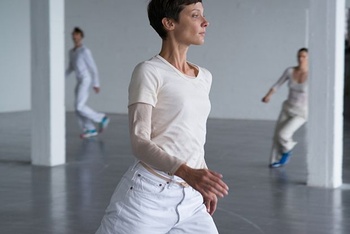
(© Anne Van Aerschot)
To the music of the French composer Gérard Grisey, De Keersmaeker translates the choreography to the conditions of a museum exhibition, which will run for nine weeks. To that end, she has worked with an extensive selection of dancers from her regular entourage and with musicians from Ictus. I admire the way someone like De Keersmaeker constantly takes on new challenges and I am delighted that this exhibition is opening during Performatik. On 22 March, De Keersmaeker, Xavier Le Roy, and Elena Filipovic will take part in a discussion at Wiels about dance within the format of an exhibition.”
Anne Teresa De Keersmaeker: Work/Travail/Arbeid. 20/3 > 17/5, Wiels
DERVISH
“I saw this performance in the Stedelijk Museum in Amsterdam, where it was presented amid Sol LeWitt’s impressive murals. Germaine Kruip works with dervish dancers who, on the basis of their religious beliefs, dance themselves into a trance and aim to pass on their faith – Sufism – via the movements of their arms. I found that combination of calmness, submission, unpretentiousness, and wonderment captivating. The Dutch artist works with geometry and the conceptual, but always succeeds in introducing emotion. I thought it would only work in a museum, but in Biel I saw this performance on a square in front of the station. In the Horta Hall at Bozar, I hope the audience will let itself be enticed to take the time and that it will succumb to the power of these extraordinary dervishes.”
Germaine Kruip: A Possibility of an Abstraction: Square Dance. 28 & 29/3, Bozar
TWELVE HOURS
“I saw this intense piano performance in Berlin. The Austrian-based Italian pianist Marino Formenti looks for a place in the city where he can play the piano, eat, and sleep, for twelve hours. It is a genuine anti-festival performance: instead of zapping quickly through the programme, you have to make time and pay attention.
To the music of the French composer Gérard Grisey, De Keersmaeker translates the choreography to the conditions of a museum exhibition, which will run for nine weeks. To that end, she has worked with an extensive selection of dancers from her regular entourage and with musicians from Ictus. I admire the way someone like De Keersmaeker constantly takes on new challenges and I am delighted that this exhibition is opening during Performatik. On 22 March, De Keersmaeker, Xavier Le Roy, and Elena Filipovic will take part in a discussion at Wiels about dance within the format of an exhibition.”
Anne Teresa De Keersmaeker: Work/Travail/Arbeid. 20/3 > 17/5, Wiels
DERVISH
“I saw this performance in the Stedelijk Museum in Amsterdam, where it was presented amid Sol LeWitt’s impressive murals. Germaine Kruip works with dervish dancers who, on the basis of their religious beliefs, dance themselves into a trance and aim to pass on their faith – Sufism – via the movements of their arms. I found that combination of calmness, submission, unpretentiousness, and wonderment captivating. The Dutch artist works with geometry and the conceptual, but always succeeds in introducing emotion. I thought it would only work in a museum, but in Biel I saw this performance on a square in front of the station. In the Horta Hall at Bozar, I hope the audience will let itself be enticed to take the time and that it will succumb to the power of these extraordinary dervishes.”
Germaine Kruip: A Possibility of an Abstraction: Square Dance. 28 & 29/3, Bozar
TWELVE HOURS
“I saw this intense piano performance in Berlin. The Austrian-based Italian pianist Marino Formenti looks for a place in the city where he can play the piano, eat, and sleep, for twelve hours. It is a genuine anti-festival performance: instead of zapping quickly through the programme, you have to make time and pay attention.
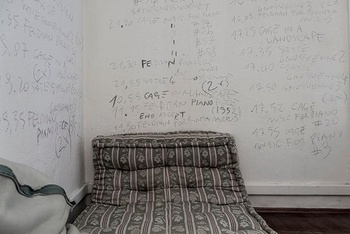
(© Luca Ghedini)
At ZSenne Art Lab, Formenti effaces himself in the music of Cage, Satie, and Eno. There are also a number of locations in the city – including Passa Porta and schools in the neighbourhood – where the public can watch and listen to his performance, and they can do so online too. That way, he turns an intimate, private activity into a broad public performance. He himself describes his work as a sort of pagan chapel where music and surroundings become one: you can easily spend a long time watching or fall asleep to it.”
Marino Formenti: Nowhere. 18 > 29/3, ZSenne Art Lab
RITUALS
“I discovered the work of this young Georgian performance collective at the Venice Biennale. For Aerobics, The Bouillon Group takes as its starting point the religious situation in their home town, Tbilisi, where apparently places of worship of the three main religions – Christianity, Judaism, and Islam – are located very near to each other.
At ZSenne Art Lab, Formenti effaces himself in the music of Cage, Satie, and Eno. There are also a number of locations in the city – including Passa Porta and schools in the neighbourhood – where the public can watch and listen to his performance, and they can do so online too. That way, he turns an intimate, private activity into a broad public performance. He himself describes his work as a sort of pagan chapel where music and surroundings become one: you can easily spend a long time watching or fall asleep to it.”
Marino Formenti: Nowhere. 18 > 29/3, ZSenne Art Lab
RITUALS
“I discovered the work of this young Georgian performance collective at the Venice Biennale. For Aerobics, The Bouillon Group takes as its starting point the religious situation in their home town, Tbilisi, where apparently places of worship of the three main religions – Christianity, Judaism, and Islam – are located very near to each other.
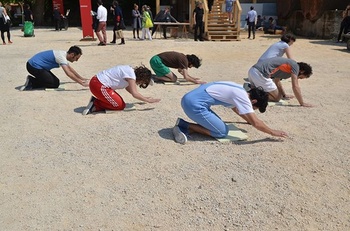
(© Bobo Mikhitari)
In this performance in public space, they mix traditional, very familiar rituals, such as making a cross, with movements from an aerobics class. In this way, they try to offer a subtle critique of the way we relate to religion: on the one hand, it leaves us cold; on the other, there is fundamentalist activity. In Brussels, they will perform on squares in front of churches, synagogues, and mosques. Like many of the other artists in this biennale, they play in the moment.”
The Bouillon Group: Aerobics. 21 & 22/3, various locations in the city
SALONS
“Throughout the festival, we are organising salons, at which artists, curators, and the public can discuss things with each other. The central focus is on the differences and overlaps between the position of a spectator in a theatre and that of a viewer in a museum. The first salon, Breaking the Frame, looks at breaking down habits in relation to time, place, object, and body in the theatre and the museum. The speakers are Shannon Jackson of the University of California, whose The Way We Perform Now is due to be published soon, and Hendrik Folkerts, one of the curators of Documenta 14. We close with Pieter T’Jonck in conversation with Hans Ulrich Obrist about his “live art exhibitions”. In between, there are thematic salons about, among other things, performance in public space, rituals, and the use of landscape in film and performance.”
Performatik Salons. 18 > 28/3, various locations
PERFORMATIK • 18 > 29/3, Verschillende locaties/Divers lieux/Various locations, www.kaaitheater.be
In this performance in public space, they mix traditional, very familiar rituals, such as making a cross, with movements from an aerobics class. In this way, they try to offer a subtle critique of the way we relate to religion: on the one hand, it leaves us cold; on the other, there is fundamentalist activity. In Brussels, they will perform on squares in front of churches, synagogues, and mosques. Like many of the other artists in this biennale, they play in the moment.”
The Bouillon Group: Aerobics. 21 & 22/3, various locations in the city
SALONS
“Throughout the festival, we are organising salons, at which artists, curators, and the public can discuss things with each other. The central focus is on the differences and overlaps between the position of a spectator in a theatre and that of a viewer in a museum. The first salon, Breaking the Frame, looks at breaking down habits in relation to time, place, object, and body in the theatre and the museum. The speakers are Shannon Jackson of the University of California, whose The Way We Perform Now is due to be published soon, and Hendrik Folkerts, one of the curators of Documenta 14. We close with Pieter T’Jonck in conversation with Hans Ulrich Obrist about his “live art exhibitions”. In between, there are thematic salons about, among other things, performance in public space, rituals, and the use of landscape in film and performance.”
Performatik Salons. 18 > 28/3, various locations
PERFORMATIK • 18 > 29/3, Verschillende locaties/Divers lieux/Various locations, www.kaaitheater.be
Read more about: Podium, Events & Festivals
Fijn dat je wil reageren. Wie reageert, gaat akkoord met onze huisregels. Hoe reageren via Disqus? Een woordje uitleg.